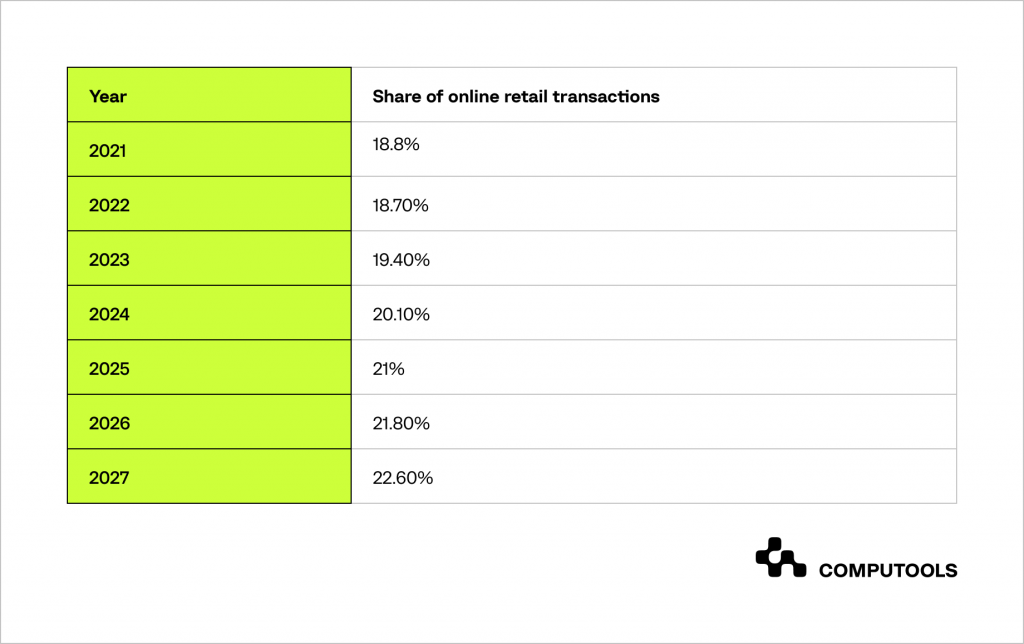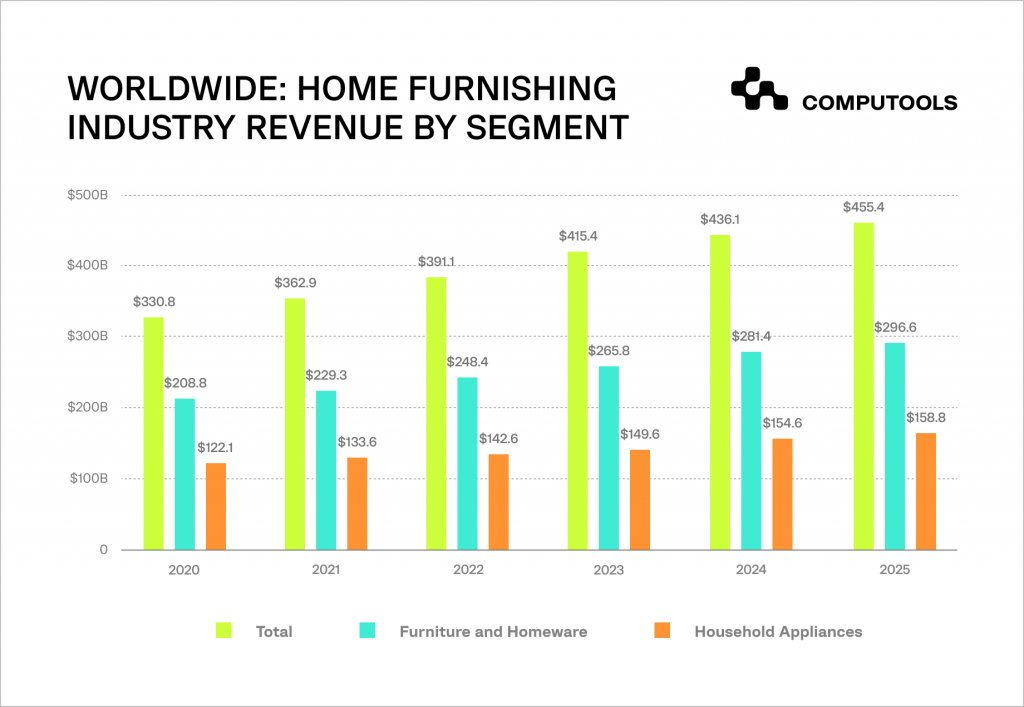The popularity of online shopping has been gradually rising in recent years, and online sales have become a major part of commerce.
E-commerce was responsible for about 20% of global retail revenues in 2024. According to Statista projections, the internet retail market will account for about 23 percent of all retail sales worldwide by 2027.

In the majority of countries, retail e-commerce has entered a new phase of gradual expansion. The earlier period of startling falls and spectacular expansion is replaced by this status quo. By precedent, total revenues from retail and e-commerce will increase only slightly in 2024.
Nonetheless, there won’t be as many extreme swings or low points globally. This year, e-commerce sales are expected to surpass $6 trillion, and 20.1% of all retail purchases will take place online.
If China is not included in the calculation, the global e-commerce share will be 12.4%.

Online purchasing with smartphones and tablets still has a lower average order value than traditional desktop computer e-commerce. Nonetheless, mobile e-commerce sales have caught up to e-retailers worldwide. Asia leads the world in smartphone-based online commerce.
Experts say that in the future home goods industry will become even more competitive. In 2024, it is projected that the home furnishing market within the eCommerce industry will continue to grow due to a combination of demographic changes, technical advancements, and growing customer preferences for online shopping.
The essential data and patterns, bolstered by illustrations, offer a thorough synopsis of the market’s anticipated performance in 2024.

With enormous online income, the home furnishing business is a major player in the e-commerce scene. At $415 billion, the global furniture e-commerce market is now quite profitable. And more expansion is expected. Estimates indicate that this amount will rise to $455.4 billion by 2025.
Therefore, brands and manufacturers should think of how to promote their products online. E-commerce trends provide many useful advice and tips on how to get around competitors and attract the attention of potential buyers.
However, each industry has its own specifics and features that must be taken into account. Studies show that the best home furnishing stores use all available methods to attract customers. Here are the home furnishing e-commerce trends in 2024 that will help to improve the online store, increase sales and customer satisfaction.
1. Rich Content and Visualization
The main attraction for consumers remains content. It is important to demonstrate to the buyer the goods that he purchases. Since the customer needs to know what exactly he will receive after the purchase in home furnishing online stores.
Focus not only on the technical characteristics of an item but also on its detailed description. Many brands focus on the functionality and convenience of the offered items. However, this way they miss the way that customers use when making decisions. Add a little emotion to the description, tell what the buyer will feel when he receives the bought item.
Another detail that is of particular importance to online home furnishing stores is a visual representation of the goods. Consumers have become more demanding not only in the quality and quantity of images. Now it’s not enough to photograph a unit of goods from several angles.
With the development of technology, the consumer wants more visual information, so additional media materials, such as video, must be included in the description. However, the undoubted advantage will be the use of augmented reality or 360-degree video, which will allow customer to consider the goods in the interior and from all sides.
Improving the user experience, allowing them to practically touch the product, the seller almost bridges the gap between offline and online stores.
2. AR Shopping Experience
There are two approaches to implementing AR in the furniture sector. AppAR requires the development of applications, but WebAR lets you use an internet browser to access augmented reality tools. Customers of the retailer will be able to personalize the furniture’s attributes (choose color, form, size, etc.) and try it on before they buy it. AR makes it possible to efficiently organize space, gather and analyze data, and create virtual exhibition halls.
Augmented reality technology’s capabilities are always growing, giving companies new ways to draw clients. 3D models have long been used by several furniture firms. Their customers are able to rotate, look beneath various nodes, inspect objects from any angle, and choose the color and style.
Customers may also use augmented reality (AR) to envision their purchases by positioning a bed, chest of drawers, and wardrobe in the space and observing how well the pieces match in terms of size and appearance. With basic equipment, the client may create his own furniture. Furniture selection is a completely engaged process for buyers.
If a prospective customer can see the type of furniture he is purchasing and even try it inside the home, brands have the power to turn shopping into an enjoyable game. By giving the customer more time to thoroughly examine the item he plans to purchase, they may lower the number of returns.
Combining AR shopping experiences with retail software solutions for furnishing industry provides home furnishing retailers with a competitive edge, enhanced customer satisfaction, reduced returns, and streamlined operations.
3. Direct-to-Consumer Shopping
Manufacturers who use the direct-to-consumer (DTC) strategy sell to customers directly. They eliminate intermediaries like traditional retail outlets and wholesalers. The brand manages everything, including sales, customer service, and design and production. With the intermediary removed, consumers may get high-quality products at reasonable costs.
The market share of DTC brands is increasing over time. When online shopping increased in 2020, the online furniture sector predicted the future of the furniture industry. On the one hand, DTC brands that were active online prospered. Conversely, physical stores hurried to establish their virtual footprint.
According to Blueprint, homeware is now the DTC category with the quickest rate of growth.
DTC furniture businesses cut out the middlemen when delivering their goods. This eliminates the sellers’ profit margins that raise the price of furniture. Customers may now get the same goods for less money.
DTC furniture manufacturers use the internet to reach their clientele. This enables them to present their brand to global internet users. As a result, they outperform their rivals in terms of brand reach and visibility.
Additionally, consumers don’t even need to leave the house to look for a larger assortment of products. Convenience influences half of consumer purchases, according to 52% of respondents today.
4. Mobile Strategy
This furniture e-commerce trend is rather important. Mobile phone users are increasingly eager to shop through this gadget and expect experience improvement.
This is where the main question appears. What you should invest your efforts and budget in a mobile version of a site or an application? Each of the options has its advantages and disadvantages.
Home furnishing stores online provide more opportunities for SEO optimization and reaching a wider audience. Thanks to indexing in search engines, retailers can attract more potential consumers. On the other hand, applications allow configuring other useful features, such as personalization, notifications, and consumer recommendations.
However, it is necessary to take into account that users give preference to only a few applications that are used constantly. But little-used applications are deleted over time. Since the home furnishing stores do not provide products that are often purchased by users, the application runs the risk of falling into the second category.
When making the final decision, home furnishing retailers should consider several key factors: the target audience, the necessary functions, and the estimated budget.
5. Omnichannel Shopping Opportunities
In the existing variety of trading platforms, it is quite difficult to get lost. That is why many sellers refuse omnichannel, preferring to focus on one, or two ways to engage customers.
Omnichannel retailing online doesn’t mean you have to be everywhere. You just have to be where your customers are. Carefully study your target audience, explore its needs and select the channels of engagement that will bring you the most benefits. A smart omnichannel strategy can increase the retailer’s turnover several times in a short time.
Here is a simple example of what an omnichannel strategy might be. Your client will find out about you on one of the trading platforms, where he makes a purchase. You send him the goods with additional booklets, information about the loyalty program and a link to similar products or additional units of the same collection.
Targeted advertising and recommendations from search engines and social networks will remind the buyer that he was already your client. This motivates him to look for similar products on your website or trading platform.
After the second purchase, send an e-mail to the customer with a notification about the sale, new products and promotions (if a subscription has been made). Also, do not forget to offer subscriptions to your pages on social networks and the ability to share a link to the purchased product.
Different types of retailing stores may use different schemes. In such a simple way, you will be able to reach a wide audience and ensure their presence in several places at once.
6. Online Consultations
According to the survey, over 30% of respondents expressed their desire for video consultations with store representatives as the most preferred virtual experience during the holiday season. It is reasonable for home furnishing business to utilize a blend of livestream shopping and virtual consultations to inform customers about their products. They offer a brief rundown of their offerings and showcase real people using them in real time.
For many shoppers, a personalised shopping experience is still very important, which is why a retailer can use e-commerce software development to combine live streaming and provide personalised advice to online customers as if they were in a physical shop.
Purchasing high-value items like beds or sofas online can make people hesitant as they prefer to inspect them in person. However, with virtual consultations, customers can now connect with store associates to get a live demonstration of the products. This enables customers to assess the product’s texture and quality as if they were physically present in-store. Essentially, it’s akin to having a personal shopper at their service.
7. Sustainability
The concern for a brand’s sustainable values remains among the top furnishing ecommerce trends. Many companies position themselves as having strong social and environmental principles. Their creators frequently discuss the connection between their design approach and sustainability beliefs. Consumers strongly favor upcycling. They are strong pro-recycling. Customers often value the objective of minimizing waste.
There’s also a trend toward minimalist design, combining utilitarian forms with decorator aesthetics. Mixing items of home décor with international styles and cultural quirks is currently fashionable. In addition to improving society, designers hope to improve the lives of craftsmen who have never had the chance to exhibit their work on a national scale.
Additionally, brands take care to indicate in the product description why there can be a delay in delivery because the products are manufactured to order. Brands emphasize in their product descriptions whether or not their items are manufactured by hand by skilled craftsmen without the use of large-scale equipment.
Customers shouldn’t anticipate incredibly quick shipment or arrival as a result. Furnishing businesses provide potential clients a chance to connect with their ideals by discussing their environmental and social principles with them.
8. Personalization
To make home furnishing retailing successful, you must fully focus on consumers. It is important to study their habits, preferences and take them into account when offering goods.
Despite warnings regarding the provision of personal data, consumers are willing to disclose it in exchange for a truly personalized experience.
Your search engine should contain the necessary filters. Besides, for registered users, consider filtering by preference. Based on the entered data and previously viewed pages, send a selection of suitable products, notify about a reduction in the price of products of interest.
Do not forget about the target home furnishing experience. On the product page, place simple recommendations like: “With this product is also buy” or “You might also like.” You can also conduct a short survey of your consumers to find out what they want to see in your online store.
9. Convenient Payment and Checkout Services
The complex and lengthy process of registering a new user is in second place in the list of reasons for refusing to buy online. On the first one is the high price of goods or delivery and taxes. This means that your checkout process should be as short as possible and with additional options.
Offer to register using social networks or allow guest (temporary) access for a one-time purchase. Do not forget to notify about the benefits of registration. For detailed information about the buyer, you can send a notification about the need to fill out a profile.
Besides, provide several payment options for the goods. The process itself should not take much time. Moreover, it should be convenient to do with any gadget. Include several modern popular payment systems in your payment methods. Be sure that all financial transactions are additionally encrypted. Notify your consumers.
You can improve your online store by using retail software development. Studies show that about 48% of consumers would like stores to simplify and improve this particular part of online orders.
According to recent home furnishing industry studies, the use of the latest technology can accelerate the development of the entire sphere tenfold.
However, online retailing must also undergo major changes. Many stores offer similar products, and to stand out in this variety, you need to create a unique user experience.
The furnishing e-commerce trends described above take into account several important factors, the main of which is customer focus. Please be free to use these tips to improve your online store, grow and develop.
Contact us at info@computools.com if you have a home furnishing retailing store. Our experts are available to assist in tailoring the perfect solution to fit your specific business needs.

Computools
Software Solutions
Computools is a digital consulting and software development company that delivers innovative solutions to help businesses unlock tomorrow.









“Computools was selected through an RFP process. They were shortlisted and selected from between 5 other suppliers. Computools has worked thoroughly and timely to solve all security issues and launch as agreed. Their expertise is impressive.”